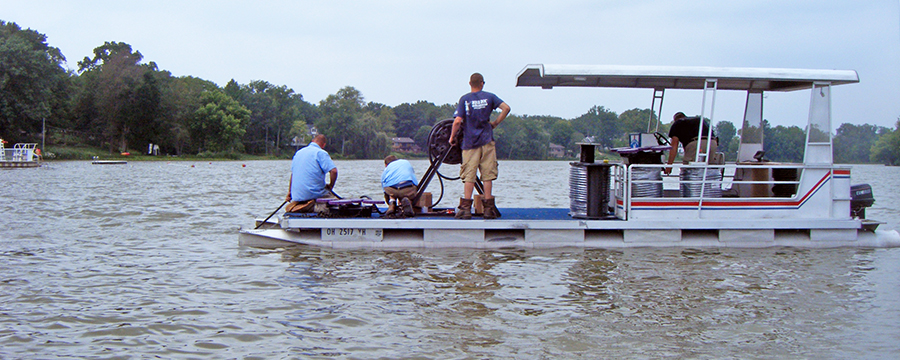Silver Lake: An Aeration Design Case Study

Aeration design has been done twice for 99 acre Silver Lake in Summit County, OH. It is a groundwater-dominated seepage lake constructed in the mid to late 1800’s that until the early 1970’s received varying amounts of wastewater. Legacy nutrients from these periods have maintained the lake as eutrophic, despite improvements in the watershed (i.e., diverted septic). The lake continually exhibits dense blue-green algal blooms, low Secchi depth (< 1 m), and summer anoxia below 4 m.
Further restoration efforts were initiated in the early 1980’s to address legacy nutrients and immediately suppress eutrophication symptoms. The first aeration design was a system installed in 1982. The basis of the aeration design reflected research and technology of the time. Results showed improved oxygen availability in the deep area and increase in zooplankton and benthic macroinvertebrates. However, there were also increases in surface chlorophyll-a, phosphorus, and algal biomass, as well as a slight decline in transparency and the continued predominance of blue-green algae. One of the main goals for the project, a reduction of blue-green algae and microcystin, was not achieved with the 1982 aeration design.
An Evaluation of Past and Present Aeration Designs
In 2014, a redesigned Vertex aeration system was installed by Aqua Doc Lake and Pond Management that reflected improved sizing of models and new aeration technology. Results for the redesigned system showed complete lake destratification, significant reductions in chlorophyll and microcystin, improved transparency, and finally a shift from blue-green algae to green algae. Overall, the redesigned aeration system has met stakeholder goals of reduced algal biomass and microcystin.
Objective: To Reduce microsysitin counts/blue-green algae, and overall algal biomass using aeration, an in-lake restoration tool that has been shown to effect phytoplankton growth, assemblages, and composition by:
Artificial Mixing:
- Algal cells are mixed to deeper, darker lake areas, decreasing the cells time in the sunlight and thereby reducing their growth rate.
- Some algae species that tend to sink quickly and need mixing currents to remain suspended (e.g., diatoms) may be favored over more buoyant species such as the more noxious blue-greens.
- Algae-eating zooplankton mixed into deeper, darker waters reduces their chances of being eaten by sight-feeding fish; hence, if more zooplankton survive, their consumption of algae cells also may increase.
Changing Water Chemistry:
- Reduces nutrient re-cycling making for less algal growth.
- Changes in the lake’s water chemistry (pH, carbon dioxide, and alkalinity) brought about by higher DO levels can lead to shifts from blue-green to less noxious green algae or diatoms.
1982 Aeration Design and Results
- The basis of the aeration design was from Lorenzen and Fast. 1977.
- The aeration system delivered 119 cubic feet per minute (cfm) air to the deepest area of the lake (12m), through a CPVC flexible pipe with 1/16 inch holes.
- Results showed improved oxygen in the deep area an increase in zooplankton and benthic macroinvertebrates. However, there were also increases in surface chlorophyll-a, phosphorus, and algal biomass, as well as a slight decline in transparency and the continued predominance of blue-green algae.
2014 Aeration Design and Results
- The basis of the aeration design was from Pastorok, Lorenzen, and Grinn. 1982; Monzur and Takashi., 2000.
- The 2014 aeration design delivers slightly more air that is evenly distributed throughout the lake.
- Results for the redesigned system showed complete lake destratification, significant reductions in chlorophyll and microcystin counts, improved transparency, and finally a shift from blue-green algae to green algae.
Discussion: Old vs. New Aeration Models
- The results are based on the different sizing models used. The 1982 design used Lorenzen and Fast (1977) model, which did not account for air distribution only mixing depth, maximum chlorophyll-a, and light limitation.
- There is no reduction in phosphorus due to sediments already saturated for iron binding.
- Changes in nitrogen, pH, along with artificial mixing were the main mechanisms for the reduction in microsysitin and Chl-a.
For more detailed information, download the full case study.
References
- Brosnan, Thomas M., and G. Dennis Cooke. “Response of Silver Lake trophic state to artificial circulation.” Lake and Reservoir Management 3.1 (1987): 66-75.
- Lorenzen, M. W., and A. W. Fast. 1977. A guide to aeration/circulation techniques for lake management, Environmental Protection Agency, Office of Research and Development, Corvallis Environmental Research Laboratory.
- Imteaz, Monzur Alam, and Takashi Asaeda. “Artificial mixing of lake water by bubble plume and effects of bubbling operations on algal bloom.” Water Research 34.6 (2000): 1919-1929.
- Pastorok, R. A., M. W. Lorenzen, and T. C. Ginn. 1982. Environmental Aspects of Artificial Aeration and Oxygenation of Reservoirs: A Review of Theory, Techniques, and Experiences. DTIC Document.
Get a Cutting Edge Aeration System that Works
Vertex Aquatic Solutions, founded in 1977, is the professionals’ choice for research based scientific consulting services, aeration systems, floating fountains, bubble curtains and biological products to enhance water quality in lakes, ponds, canals, marinas and reservoirs. As respected leaders in the lake management industry the Vertex team of aquatic biologists, limnologists, fisheries scientists and engineers work together to deliver science-based, environmentally sound solutions to complex waterbody issues. Our products and services are delivered through an international network of qualified, experienced waterbody professionals who provide local support, service and pond management expertise to customers.
← Previous